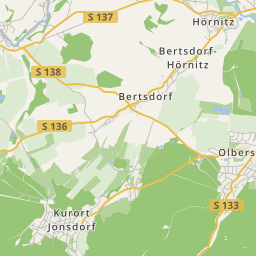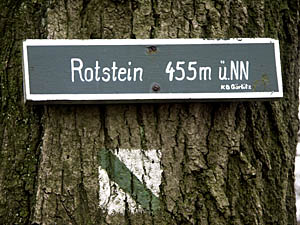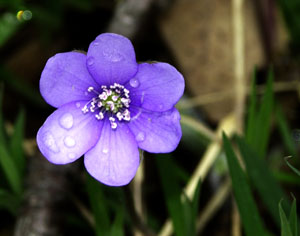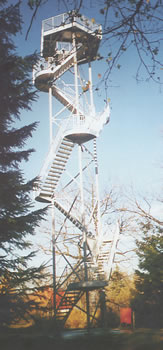












At the "Roten Stein"
In Saxon's oldest Nature Reserve at the Rotstein grow 530 different plant species. The nature conservation in 1912.
The Rotstein-Massif, which has several peaks, is one of the most interesting mountainous hiking destinations in the region. The Rotstein shows clearly a horse-shoe formed shape with three hilltops. The 455 metre high Rotstein, the 421metre high Hengstberg and the 396 metre high Georgenberg forms the end in the south-west direction.

The Rotstein is from the botanical point of view one of Saxon's most interesting mountains. Roughly 530 different species of flowering plants and higher cryptogams can be found here. The Rotstein's most well-known plant is the liverwort, which thrives in spring. There are also many other rare plants to be found at the deciduous forest. For example spurge laurel bushes, the Wald-Gedenkemein, last exemplars of silver firs, forest primroses, Turk's-cap lily, yew trees, gladiolas and the arum.
But there is also a rich fauna to be found. Song thrushes chirp, woodpecker hammer, turtle doves turtle and hedgehogs, fat dormice or hazel dormice wake up with the start of spring.

The in 1872 built mountain guesthouse was extended in 1879 and 1897. Today a familiar Berghotel is situated at the peak.
The new observation tower was inaugurated on 28.10.2000The observation platform can be reached via 101 steps. The tower is 21 metre high and one has a great view over the Oberlausitzer highlands up to the Iser- and Riesengebirge.
Apart from the botanical features the Rotstein offers its visitor a lot of other points of interest. A late Slavic-early German fortress formed into a double parapet can be found at the south-east peak. We can see at some places extensive basalt block seas and stone heaps. Near the guesthouse in northern direction stand an especially bulky basalt pillar. At this rock the devil, coming from Görlitz, apparently made a stop-over to mend his clothing. At the Georgenberg, hidden in the forest, is the ruin of the Georgen Chapel situated. It was probably built in the 14th century by the bishop Benno.